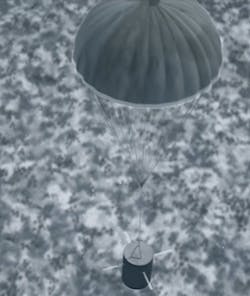SRC developing enabling technologies for artillery-delivered jamming and spoofing electronic warfare (EW)
PICATINNY ARSENAL, N.J. – U.S. Army researchers needed the ability to deliver electronic warfare (EW) spoofers and jammers by field artillery in contested corners of the world. They found their solution from SRC Inc. in Syracuse, N.Y.
Officials of the U.S. Army Team Picatinny at Picatinny Arsenal, N.J., have chosen SRC for a research project to develop the artillery-delivered ability to go after enemy formations, as well as to conduct control and disruption missions.
SRC engineers are capitalizing on the company's Silent Impact technology, which uses a 155-millimeter artillery shell as a delivery mechanism to extend navigation warfare (NAVWAR), NAVWAR situational awareness, and EW capabilities deep into contested territory to overwhelm and overmatch an adversary.
The system can deliver cyber electromagnetic attack payloads in-flight, using parachutes to stay aloft for extended periods, and on the ground after it lands. The system also provides advanced cyber and non-traditional intelligence, surveillance, and reconnaissance for identifying and exploiting adversaries.
Related: The new world of counter-drone technology
EW systems are designed to fit into existing artillery munition casings to help deliver enhanced situational understanding, giving soldiers the intelligence they need to observe adversaries, move forces to where they are needed most, decide on a courses of action, and carry out mission plans.
SRC's work with the Army is part of the first phase of a spiral capability to go after enemy formations and control and disruption missions. Iterative development, explains Mike Ryan, assistant vice president of Army accounts at SRC.
The project uses non-lethal jamming and spoofing options to control the battlespace, and enhance lethality. SRC experts anticipate that the enabling technologies they develop for the Army eventually become part of a future program of record in as little time as two or three years.
Related: Today's battle for the electromagnetic spectrum
Live-fire testing of Silent Impact technologies are expected by the end of this year, and "it could be three or four years before we see this hit the battlefield," Ryan says.
SRC's work with the Army on this project started in 2018 with a cooperative research and development agreement (CRADA) to study deploying disruption, decoy, and deception effects via artillery.
Disruption can jam enemy radar, communications, and other RF and microwave systems. Decoy and deception can spoof the enemy by mimicking signals of concern to throw-off an adversary's signals intelligence.
"It could look like blue-force signals that are where they should not be," Ryan explains. "It could look like a squad communicating, to create multiple dilemmas for the adversary. This is an overwhelming effect.
Silent Impact technologies also can provide electronic intelligence payloads to the battlefield to listen for an adversary's radio signals to detect, identify, and locate threats on the ground.
For more information contact SRC online at www.srcinc.com, or the Army's Team Picatinny at www.pica.army.mil.

John Keller | Editor-in-Chief
John Keller is the Editor-in-Chief, Military & Aerospace Electronics Magazine--provides extensive coverage and analysis of enabling electronics and optoelectronic technologies in military, space and commercial aviation applications. John has been a member of the Military & Aerospace Electronics staff since 1989 and chief editor since 1995.

